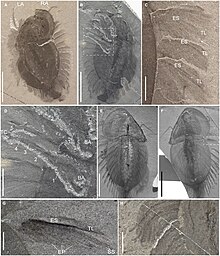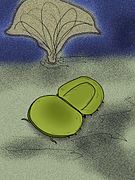Nektaspida
| Nektaspida Temporal range:
| |
|---|---|

| |
| Naraoia compacta fossils with preserved appendages | |
| Scientific classification | |
| Domain: | Eukaryota |
| Kingdom: | Animalia |
| Phylum: | Arthropoda |
| Subphylum: | †Trilobitomorpha |
| Order: | †Nektaspida Raymond , 1920
|
| Families | |
Nektaspida (also called Naraoiida, Nektaspia and Nectaspida) is an extinct
Naming history and taxonomic placement
The order was originally proposed by Raymond in 1920 as Nektaspia.
Anatomy

The group is united by several morphological characters, including reduced or absent lateral eyes, a hypostome with a natant attachment, extensive articulation overlap between unfused trunk tergites, and fused pleurae that do not form lateral spines.[5] Preserved soft tissue of the group indicates that the cephalic (head) shield of nektaspids and liwiids contained branched digestive glands.[6] The Naraoiidae have their exoskeletons mostly composed of only two major shields, which have a single articulation point.[7]
Ecology
The naraoiids have been interpreted as benthic organisms that were opportunistic scavengers and predators of soft-bodied prey, with the spine-like endites of the limbs possibly allowing soft-bodied prey to be shredded before ingestion. The differences in gut morphology between some species of naraoiids suggests that some species only intermittently fed, while others regularly fed.[8]
Evolutionary history
The group first appeared and was most diverse in the
Gallery
-
Life restoration of Misszhouia
-
Drawing of the carapace of the incertae sedis nektaspid Buenaspis
-
Restoration of the emucaridids Kangacaris (blue, left) and Emucaris (yellow, right)
-
Fossil of the Ordovician liwiid Tariccoia from Sardinia
-
Life restoration of the naraoiid Pseudonaraoia
-
Fossil ofMisszhouia longicaudata
References
External links
- Are Naraoids trilobites?—photographs of specimens and discussion of classification controversy.
- Order Nectaspida—more technical overview with references and descriptions of known genera.






